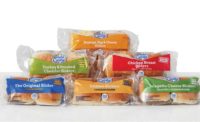In 1921, Walt Anderson and E. W. “Billy” Ingram, Sr. borrowed $700 and opened their first White Castle restaurant in Wichita, Kan. The loan was re-paid in 90 days and today, the $650 million, family-owned company employs more than 10,000 people company-wide and operates over 400 restaurants throughout the Midwest and portions of the East coast.
At A GlanceCompany: White Castle Headquarters:Columbus, Ohio Top Executive: Bill Ingram, chief executive officer and chairman; Lisa Ingram, president Distribution:Nationwide, and soon to Canada No. of Employees:10,000 company-wide Annual Sales: $650 million Distribution:Supermarkets, c-stores, vending, concessions, military, drug, club, mass and dollar. |
But, it’s not just its ability to revolutionize the fast food hamburger industry that makes White Castle king of the retail freezercase. That’s because White Castle Distributing, LLC, Columbus, Ohio, continues to improve the quality of its burgers, while incorporating energy efficient practices and operating as pure (White) and strong (Castle) as possible.
These are just a few reasons why Refrigerated & Frozen Foods named White Castle as its 2014 Frozen Foods Processor of the Year.
Crowning achievements
As a family-owned business that’s been in operation for more than 90 years, White Castle continues to reign in innovation. For example, it first introduced the frozen hamburger patty in 1931, and in 1949, introduced its 5-hole technology, which prompts a faster way to cook the patties (steam rises through the holes, cooking the patty all the way through).
But, it’s the steam-grilled cooking procedure with 100% USDA-inspected beef over a bed of onions that makes a White Castle hamburger so unique, says Rob Camp, vice president and general manager.
“Our patented ‘5 holes’ in our hamburger patties allow the steam from the onions to penetrate our special buns and provide that unique taste that only White Castle can offer. It’s that process that is ideally suited for a frozen sandwich when re-heating in a microwave or other warming method. Our sandwiches are flash frozen after cooking, so the steam is locked into the bun and then released after re-heating to keep our buns hot and tasty, just like in the restaurants,” he adds.
White Castle also underwent a packaging redesign, transforming to “a design that ‘popped’ on the shelf for the consumer and differentiates us from our competitors,” says Janet Fallon, director of sales and marketing.
“We recently changed the logo on our packaging to better align ourselves with the current logo utilized by our restaurant brand. The bright chevron color design along with the high-definition photography makes the packaging very visible on the shelf and clearly shows the delicious burgers and reminds our consumers of their favorite ‘comfort’ food,” she adds.
To maintain an energy efficient profile, White Castle restaurants switched to 100% recycled brown-paper sacks and corrugated Crave cases and re-use the cardboard boxes from the sandwich buns shipped from the company’s Evendale, Ohio, bun bakery.
“Today, each box is re-used approximately five times. This practice has saved White Castle thousands of new cardboard boxes annually,” says Brad Rife, assistant vice president of operations. “We continue to reduce waste in our castles by recycling and testing food scraps diversion in our central Ohio locations. Additionally, we continually test new energy efficient technologies within our facilities, including LED lighting and efficient appliances and fixtures. Lastly, we continually educate our team members about energy efficiency and waste reduction strategies within the workplace as well as within their homes.”
White Castle also opened the doors to its LEED Gold-certified frozen food manufacturing facility in Vandalia, Ohio (see “A Fortress of Energy Efficiency,” page 18).
From restaurants to the freezer aisles
It was 1987 when the fast food king brought its Sliders to retail. In fact, White Castle is said to be the first fast food restaurant to bring its products from the restaurant to the retail channel, available in supermarkets, c-stores, vending, concessions, military and drug, club, mass and dollar stores.
However, many of White Castle’s frozen options come from its restaurants, where consumers actually request that certain menu items be made available in retail. Examples include the newly introduced Jalapeno cheeseburger and Chicken Breast sandwich, as well as the traditional hamburgers and cheeseburgers.
“Our small hamburger and cheeseburger size means you can tailor it to your taste, and have a snack or a meal depending on what fits best for your day and your personal diet,” says Jamie Richardson, vice president, corporate relations.
White Castle also curtails negative connotations to the frozen foods industry by producing products made from the finest ingredients, including using only 100% USDA-inspected beef formed into perfect patties shipped from one of its three meat processing plants— Zanesville, Ohio; Orleans, Ind.; and Lebanon, Ind.—in addition to baking its own buns out of its Evendale, Ohio, bakery.
“The White Castle cheeseburger is the No. 1 selling frozen sandwich in retail stores and vending operations across the country, [according to Nielsen, total frozen appetizers and sandwiches, ended Oct. 4],” says Camp. “While our restaurants are regionally located, our iconic brand is known nationwide. Our retail products enjoy strong sales in all 50 states. A new avenue of growth in 2014 has been our entry into military retail sales. For 2015, we also plan to expand into Canada.”
To date, White Castle pumps out close to 6.7 million burgers a week, and continues to find ways to develop new products and save the environment while satisfying consumers’ cravings.
“It’s surprising how many people who visit our restaurants don’t know we have products available in retail grocery, and there are people who’ve been eating our grocery products who didn’t realize we’re a restaurant chain, too,” says Camp.
From restaurants to grocers’ freezercases, White Castle reigns the frozen foods aisle and continues to revolutionize the fast food hamburger industry.
Take a tour of White Castle's new 80,000-square-feet, LEED Gold-certified frozen food plant in Vandalia, Ohio.
White Castle’s Royal Duties
White Castle isn’t just about making delicious, craveable foods like its iconic Original slider, says Jamie Richardson, vice president, corporate relations for the Columbus, Ohio-based fast food giant.
“We are an integral part of the communities in which we live and work, and we seek to make a difference in the lives and families of our team members, our loyal customers and the community at large,” he adds.
Here’s a breakdown of some of the company’s royal duties:
Castle Shares. A corporate charitable program that feeds hunger, hopes and dreams in local communities. Its Castle Shares Team Member Relief Program provides a relief grant of up to $1,500 for any team member who encounters an unexpected hardship. Administered through a partnership with the Salvation Army and created by White Castle CEO Bill Ingram, the program was developed in the wake of Superstorm Sandy.
Ingram-White Castle Foundation. Founded in 1949, the foundation provides nourishment to those who hunger for knowledge, independence and self-sufficiency, whether it be scholarship funds or grants to support disadvantaged students, to name a few.
Cravers Hall of Fame Program. This is a formal process in which loyal Cravers can submit letters, videos and testimonials sharing their intense love for Sliders. A contest is held each year, kicking off in May, which is National Hamburger Month.
Crave Time Cook Off. In 1991, a White Castle team member used Sliders instead of bread and sausage in a family recipe to make turkey stuffing. It was then, a cookoff was born. Fans submit unique and delicious recipes featuring 10 White Castle Sliders. Winners receive a year’s worth of Sliders, one Crave Case per for 52 weeks.








